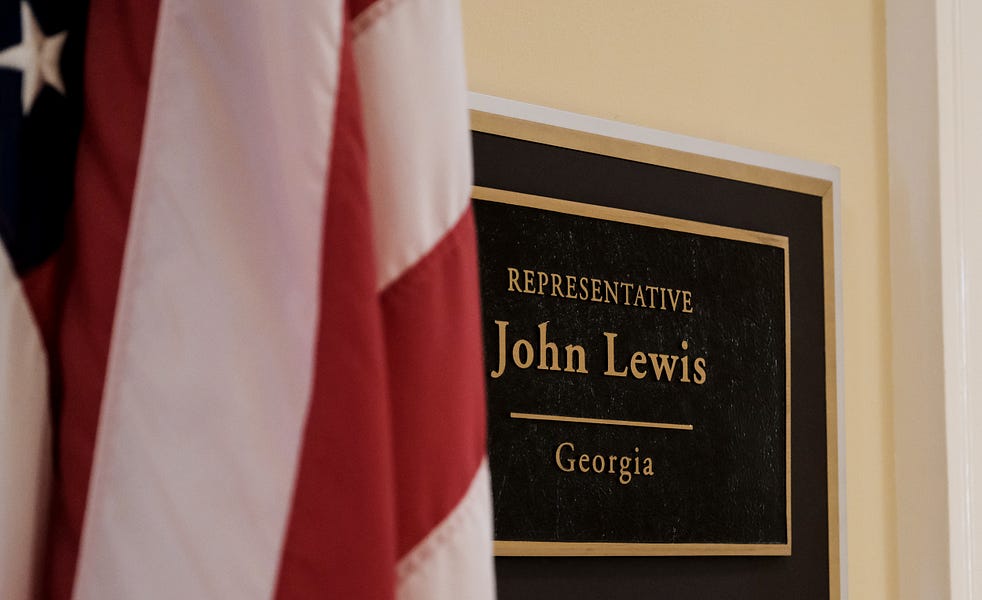Just seven months after Lyndon B. Johnson signed the 1964 Civil Rights Act into law, John Lewis—then the 25-year old leader of the Student Nonviolent Coordinating Committee—led nearly 600 peaceful demonstrators across the Edmund Pettus Bridge in an attempt to begin a civil rights march from Selma to Montgomery. Now known as “Bloody Sunday,” the March 7, 1965 march to advocate for the constitutional voting rights of African Americans was swiftly disrupted by a cadre of Alabama state troopers.
Despite the skull fracture Lewis endured that day—and the 40 arrests he experienced in the years before and after—he remained committed to voting rights reform up until his death on Friday, with a legislative record to show for it. Most recently, Rep. Lewis presided over the House of Representatives’ passage of the Voting Rights Advancement Act in December. The bill has been renamed in his memory.
Now that Congress is back in session this week, Democratic lawmakers are pushing bipartisan support for the bill as a tribute to Lewis’ civil rights legacy. The John Lewis Voting Rights Advancement Act seeks to restore and expand provisions of the Voting Rights Act of 1965 (VRA) that were struck down in 2013 by the Supreme Court’s ruling in a case called Shelby v. Holder.
Section 2 of the VRA continues to prohibit any “standard, practice, or procedure” that “results in a denial or abridgement of the right of any citizen … to vote on account of race or color.”
But Democrats are keen on reinstating the “coverage formula” of the VRA, which dictated which states and voting precincts needed to obtain federal “preclearance” before changing their election laws. When the law was initially passed, this coverage formula included states and local voting precincts that had a history of “literacy and knowledge tests, good moral character requirements, [and] the need for vouchers from registered voters,” and had “less than 50 percent voter registration or turnout in the 1964 Presidential election.” Included in Section 4(b) of the VRA, the formula was originally set to expire after five years but was reauthorized several times by Congress until the Supreme Court struck it down in 2013.
While the formula has been applied to isolated voting precincts across the country—including counties in California, Michigan, and New York—it has mainly prevented former Confederate states from implementing voting restrictions like the ones imposed as early as the 1890s to undermine the African American right to vote.
Once a jurisdiction was covered under Section 4(b)’s formula, the locality was required to preclear any changes to their election laws at the federal level and had the burden to show that those changes would not disproportionately affect minority voters. With the invalidation of that formula, voters can still challenge discriminatory voting laws after they have been passed, but the burden is now on the voters to show that the law undermines their right to vote.
In light of this shift, Democratic lawmakers claim that the Supreme Court’s invalidation of the coverage formula has opened the floodgates to a flurry of discriminatory electoral laws that were formerly subject to strict federal oversight. On Wednesday, Sen. Patrick Leahy (D-Vermont) reintroduced the bill alongside 47 of his Senate colleagues. The bill maintains unanimous support from Democrats and just one Republican co-sponsor, Sen. Lisa Murkowski of Alaska.
“There is nothing more fundamental than the right to vote, which is why I am proud to once again join my colleague Senator Leahy as a co-sponsor of the John Lewis Voting Rights Advancement Act,” Murkowski told The Dispatch on Wednesday.
“The law [Lewis] nearly died for has been gutted by the Supreme Court,” Senate Minority Leader Chuck Schumer (D-New York) said on the Senate floor Monday. Sen. Sheldon Whitehouse (D-Rhode Island) told The Dispatch that“the best way Democrats and Republicans can honor John’s legacy is by taking action to safeguard voting rights—rights he risked his life for.”
But the bill is unlikely to garner enough Republican support to pass the Senate, and White House aides have threatened that Trump would veto the bill in the off chance it did reach his desk. Regardless, issues around voting access will continue to feature prominently in Democratic campaigns, which have long cited the Supreme Court’s decision in Shelby as a major impediment to voting rights in the country.
In the 1966 decision South Carolina v. Katzenbach, the Supreme Court recognized that federal oversight was crucial in remedying the link between discriminatory electoral laws and voter suppression in many voting precincts across the country as a “legitimate response” to the “insidious and pervasive evil” of voter suppression during Jim Crow.
In 2013, however, the Supreme Court ruled that enough progress was made in the decades following Katzenbach that the foundation for the coverage formula no longer existed and therefore impermissibly intruded on states’ power to regulate their own elections. Writing for the majority, Chief Justice John Roberts argued that “voter turnout and registration rates now approach parity,” invalidating the coverage formula on the grounds that it was “based on decades-old data and eradicated practices.”
The court, however, left in place Congress’ ability to require states and localities to preclear changes to their voting laws if they passed an updated formula. To reinstitute preclearance, then, Congress would need to create a new formula based on “current conditions in those areas rather than conditions that existed many decades ago,” according to Rick Pildes, a professor of constitutional law at the New York University School of Law.
And that is exactly what the current bill seeks to do. “If the bill is passed, it will bring into these special coverage provisions certain areas of the country that had never been included before and would take out certain areas that had been included,” Pildes told The Dispatch. “It would mean that in these covered areas, no change could be made with respect to their voting practices without the Department of Justice or a federal court determining that the change would not have the purpose or effect of being discriminatory.”
Photograph by Michael A. McCoy/Getty Images.







Please note that we at The Dispatch hold ourselves, our work, and our commenters to a higher standard than other places on the internet. We welcome comments that foster genuine debate or discussion—including comments critical of us or our work—but responses that include ad hominem attacks on fellow Dispatch members or are intended to stoke fear and anger may be moderated.
With your membership, you only have the ability to comment on The Morning Dispatch articles. Consider upgrading to join the conversation everywhere.